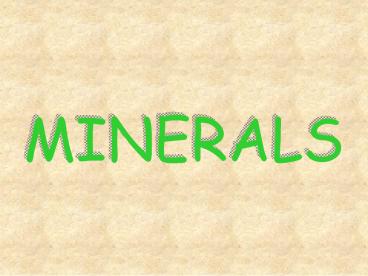MINERALS - PowerPoint PPT Presentation
1 / 24
Title:
MINERALS
Description:
Title: Introduction Geology 1303 Earth Science Author: Kate C. Miller Last modified by: CUSD95 Created Date: 12/28/1999 5:24:29 AM Document presentation format – PowerPoint PPT presentation
Number of Views:68
Avg rating:3.0/5.0
Title: MINERALS
1
MINERALS
2
- What is a mineral?
- How do we differentiate a mineral from a piece of
wood or a human? - What is a rock?
3
Minerals
- What is a mineral?
- Naturally occurring (not man-made)
- Inorganic
- Crystalline Solid (interlocked pattern of
molecules) - Definite chemical structure which give it unique
physical properties. - Ex. Diamonds
4
Minerals vs. Rocks
- There are nearly 4000 known minerals - but most
rocks are formed by only a few dozen minerals. - Rocks are aggregates (mixtures) of minerals. So .
. . minerals are the building blocks of rocks. - Question
- How do minerals come together to form a rock?
5
Composition and Structure of Minerals
- To understand how minerals form, we need to
understand the characteristics of elements and
atoms. - Elements are the basic building blocks of
minerals. There are over 100 known elements. - Atoms are the smallest particle of matter that
exhibits all the characteristics of an element.
6
Composition and Structure of Minerals
- Atoms are made up of
- Nucleus, which contains
- Protons- positive electrical charges
- Neutrons - no charge
- Shells which surround the nucleus and contain
Electrons - negative electrical charges - The mass (density) of an element depends on the
number of protons and neutrons in the nucleus.
7
Combining Elements to Form Minerals
- Elements combine with each other to form a wide
variety of minerals. - The new mineral (compound) will have very
different physical properties from the elements
that combined to form it. - Ex 1 Calcium
- 1 Carbon CaCO3
- 3 Oxygen
8
Combining Elements to Form Minerals
- Since rocks are mixtures (not chemical
combinations) of minerals, minerals keep their
physical properties within a rock. - Question Is it possible for two different
minerals to have the same chemical composition? - YES! Both diamond and graphite are made of
carbon. The difference between these two
minerals is the way in which the carbon atoms are
arranged.
9
Rock Forming Minerals
- The most common rock forming minerals are
composed of 8 elements - Oxygen (O)
- Silicon (Si)
- Aluminum (Al)
- Calcium (Ca)
- Sodium (Na)
- Potassium (K)
- Iron (Fe) and Magnesium (Mg)
- There are just a few dozen minerals that we call
the rock-forming minerals.
10
Silicate Minerals
- Silicate minerals
- Contain both silicon (Si) and oxygen (O)
- The most common rock-forming minerals
- May contain one or more other elements
- Silicates make up 96 of the Earths crust.
11
Silicate Mineral Groups
- Feldspars form depending on which metal
combines with the Si O atoms - Two common types of feldspars
- Orthoclase (K, Al)
- Plagioclase (Ca, Na)
- Most plentiful mineral group
- Quartz composed ONLY of Si O atoms
- ( NO other elements )
12
Silicate Minerals
Biotite
Quartz
Muscovite
Plagioclase Feldspar
13
Non-Silicate Minerals
- Major groups Contain no Silicon
- Oxides (metal O) Ex. Hematite, magnetite
- Sulfides (metal S) Ex. Pyrite fools gold,
galena - Sulfates (S O) Ex. Gypsum plaster
- Halides Ex. Halites salt
- "Native" elements (dont combine with any other
elements) Ex. Gold, silver, carbon, copper - Carbonates (C O) Ex. limestone, marble
- Non-Silicates make up 4 of the Earths crust.
14
Non-Silicate Minerals
Pyrite
Hematite
Halite (salt)
15
Non-Silicate Minerals
Gold
Flourite
Galena
16
Mineral Properties
- Minerals have lots of different properties that
help us identify them - Crystal form -set of faces that have a definite
geometric relationship to one another. - Luster metallic or nonmetallic shine
- Color
- Streak minerals color in powdered form
- Hardness Mohs hardness scale/scratch resistance
of one mineral against another - Cleavage how it breaks along preferred planes
- Fracture no preferred plane (no flat surface)
- Specific gravity -describes the density of the
mineral - Taste, Smell, Fluorescence etc.
17
Identifying Minerals
- Color can help with mineral identification.
- Color of the mineral
- Color of the streak on a porcelain plate
- Example Hematite is gray in color and has a red
streak
18
Identifying Minerals
- Luster shiny or dull
- Luster - the way a mineral reflects light
- Look for luster on a fresh surface.
- The three major types of luster are
- metallic,
- glassy (vitreous)
- and dull.
19
Name
Cleavage how mineral breaks
Plane
Basal
1
Prismatic
2
3
Cubic
Rhombo- hedral
3
20
(a) cubic (b) 12-sided (c) octahedral (d)
hexagonal
21
Identifying Minerals
- Most minerals (except metals) have one or more
cleavage planes that also help in determining
their identity. - Cleavage Plane A region where a rock cleanly
splits - Occur in areas of weak bonds between atoms and
molecules. - Mica has 1 cleavage plane
- Halite has 3 cleavage planes
22
Mohs hardness scale
- 1. Talc 7. Quartz
- 2. Gypsum/fingernail 8. Topaz
- 3. Calcite/penny 9. Corundum
- 4. Fluorite 10. Diamond
- 5. Apatite
- 6. Potassium Feldspar/steel nail
Scratch one mineral against another to see how
resistant it is.
23
Material Mohs hardness scale
Streak plate 7
Glass plate 5.5 - 6
Nail 4
Copper/Penny 3
Fingernail 2
24
Mineral Identification
- Common items to test for hardness
- A fingernail (2.5) will scratch gypsum and be
scratched by calcite - A penny (3) is scratched by fluorite
- Glass (5.5- 6) scratches apatite and is scratched
by orthoclase (a feldspar)

